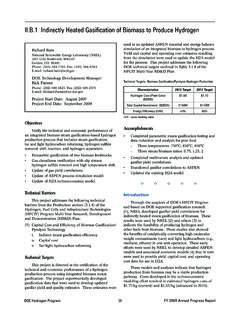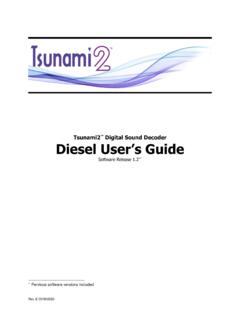Transcription of Fuel Cell Technologies Overview
1 Dr. Dimitrios Papageorgopoulos, HFTO Fuel Cell Technologies Program Manager2021 Annual Merit Review and Peer Evaluation MeetingFuel Cell Technologies OverviewJune 7, 2021 Washington, DC2 OFFICE OF ENERGY EFFICIENCY & RENEWABLE ENERGYHYDROGEN AND FUEL CELL Technologies DEPARTMENT OF ENERGYFuel Cell Technologies : Building an Affordable, Resilient, and Clean Energy EconomyFuel cells use a wide range of fuels and feedstocks; deliver power for applications across multiple sectors; provide long-duration energy storage for the grid in reversible systems3 OFFICE OF ENERGY EFFICIENCY & RENEWABLE ENERGYHYDROGEN AND FUEL CELL Technologies DEPARTMENT OF ENERGYI nnovative RD&D Considers End Use RequirementsGoal:Fuel cells that are competitive with incumbent and emerging Technologies across applications4 OFFICE OF ENERGY EFFICIENCY & RENEWABLE ENERGYHYDROGEN AND FUEL CELL Technologies DEPARTMENT OF ENERGYA pplication-Driven TargetsEXAMPLE 2030 TARGETSFUEL CELLS FOR LONG-HAUL TRUCKS $80/kW fuel cell system cost 25,000-hour durabilityFUEL CELLS FOR STATIONARY POWER $1000/kW fuel cell system cost 80,000-hour durabilityREVERSIBLE FUEL CELLS FOR ENERGY STORAGE $1800/kW system cost ($ LCOS) 40,000-hour durabilitySystem-level targets to achieve competitiveness with incumbent and emerging technologiesA combined target for HD MEA development: Improve power at appropriate voltage measured afterdurability target.
2 Achieve kW/gPGMpower ( A/cm2current density)* at V after 25,000 hour-equivalent accelerated durability test**Total PGM loading constrained to mg/cm2.**Heavy duty by guideline component and stack level targets/milestonesEXAMPLE:Revised targets and milestones being updated in Program Plan 5 OFFICE OF ENERGY EFFICIENCY & RENEWABLE ENERGYHYDROGEN AND FUEL CELL Technologies DEPARTMENT OF ENERGYRD&D Strategies Address Fuel Cell ChallengesWith emphasis on HD Heavy duty effortsprioritizeefficiency and durabilityto achievecost and lifetime targets Transferable benefits for mediumduty and stationary applications Leverages previous light dutyefforts in technology improvementand cost reductions6 OFFICE OF ENERGY EFFICIENCY & RENEWABLE ENERGYHYDROGEN AND FUEL CELL Technologies DEPARTMENT OF ENERGYFuel Cells Program BudgetFuel Cell Technologies FundingFuel Cell Materials & Components Low-PGM MEAs and MEAcomponents with enhanceddurability PGM-free catalysts/electrodes Bipolar plates.
3 Gas diffusion layers Advanced manufacturing &sustainabilityFuel Cell Systems Integration Stacks BOP components includingpower electronics SuperTruckIII System analysis Advanced manufacturing &sustainabilityProgram Direction7 OFFICE OF ENERGY EFFICIENCY & RENEWABLE ENERGYHYDROGEN AND FUEL CELL Technologies DEPARTMENT OF ENERGYRD&D Portfolio Guided by Analysis 8 OFFICE OF ENERGY EFFICIENCY & RENEWABLE ENERGYHYDROGEN AND FUEL CELL Technologies DEPARTMENT OF ENERGYH istoric Reduction in LDV Hydrogen Fuel Cell CostCost Reductions Achieved Through: Reduced Pt catalyst loading (30% since 2008) Increased cell power density (>70% since 2008),allowing for smaller stacks Optimized BOP components and system design Innovative manufacturing processes for BOP andstack estimated cost of an 80-kWnet automotive PEMFC system is projected to be $76/kWnetwhen manufactured at 100,000 units/year and adjusted to meet 8,000 hours of durability70% cost reduction from 2008 to 20209 OFFICE OF ENERGY EFFICIENCY & RENEWABLE ENERGYHYDROGEN AND FUEL CELL Technologies DEPARTMENT OF ENERGYFuel Cells are Attractive for Medium-and Heavy-Duty VehiclesExamples:H2fuel cells can offer several advantages over incumbent Technologies including higher efficiency, zero-emissions, higher torque, fast-fueling, no noise pollution, while addressing longer range demandsRail: Fuel cells have lower fuel consumption over the duty cycle vs.
4 diesel locomotivesSource:Maritime: Largest benefits for applications spending substantial time operating at less than full load (ferries and towboats)HD Trucks: Fuel cell trucks have zero vehicle emissions and can reduce the well-to -wheels GHG emissions by >95% compared to conventional trucks (Preliminary Analysis)GHG Emissions, g/mileFuel cell trucks introduce significant social benefits improving air quality of communities around freight facilities10 OFFICE OF ENERGY EFFICIENCY & RENEWABLE ENERGYHYDROGEN AND FUEL CELL Technologies DEPARTMENT OF ENERGYHDV Fuel Cell Durability-Adjusted Costs (for 25,000 hours lifetimes) $323/kWnetfor 1,000 units/year $196/kWnetfor 50,000 units/year $185/kWnetfor 100,000 units/yearCatalyst cost is projected to be the largest single component of PEMFC stack costStack cost dominates system cost11 OFFICE OF ENERGY EFFICIENCY & RENEWABLE ENERGYHYDROGEN AND FUEL CELL Technologies DEPARTMENT OF ENERGYM eeting HD Fuel Cell Cost Targets -Viable Pathway$162$323$42$32$12$75$15$8$22$16$1 6$5$80$60$0$50$100$150$200$250$300$35027 5kW Heavy-Duty Fuel Cell System Cost [2016$/kWnet]
5 2021 HDV SystemCost at 1k sys/yrDOE Ultimate TargetDOE 2030 Target1k to 10k sys/yr10k to 50k sys/yr2025 HDV SystemCost at 10k sys/yr50k to 100k sys/yrIncreased Power Density & Reduced PGM loading Improved DurabilityAir Management+ BPPI ncrease Cell Active Area Membrane + BOPI mprovement in Stack/BOP ComponentIncrease in Production VolumePGM loadingfrom to mgPGM/cm2 Reduce Stack OverizingReduce Stack oversizing PGM loadingfrom to mgPGM/cm212 OFFICE OF ENERGY EFFICIENCY & RENEWABLE ENERGYHYDROGEN AND FUEL CELL Technologies DEPARTMENT OF ENERGYOn-Road Transit Fuel Cell Bus MilestoneFuel cell electric buses (FCEBs) demonstrated over 25,000 hours operating timeTwelve systems have surpassed 25,000 hours, including one with > 32,000 hours accumulated by 15 FCEBs included in a fleet operated by Alameda-Contra Costa Transit District (AC Transit)13 OFFICE OF ENERGY EFFICIENCY & RENEWABLE ENERGYHYDROGEN AND FUEL CELL Technologies DEPARTMENT OF ENERGYOn-Road Transit Fuel Cell Bus Durability AssessmentFCEB durability was determined to be 17,000 hours with less than 20% degradation(8,500 hours with less than 10% degradation)Status is based on real-world FCEB data collected between 2011 and 2017 Relative degradation in fuel economy is auseful approximation for voltage degradationat rated power Targeted 20% degradation at 25,000 hoursenables the FCEB to maintain relatively highperformance and fuel efficiency across itsoperational lifetime (not necessarily reflectingFCEB end-of-life)
6 Fuel economy of four representative FCEBs, with linear fits used to determine the average rate of fuel economy loss14 OFFICE OF ENERGY EFFICIENCY & RENEWABLE ENERGYHYDROGEN AND FUEL CELL Technologies DEPARTMENT OF ENERGYT otal Cost of Ownership and Durability are Key Drivers for HD ApplicationsHigh fuel cell system durability is essential for heavy-duty applications. Long-haul trucks require a lifetime of over 1 million miles and 25,000 operation hoursD. Cullen et. al. Nature Energy, 2021 Technical System Targets: Class 8 Long-Haul Tractor-Trailers Characteristic Units Targets for Class 8 Tractors-TrailersInterim (2030) Ultimate Fuel Cell System Lifetime[hours] 25,000 30,000 Fuel Cell System Cost[$/kW] 80 60 Fuel Cell Efficiency (peak) [%] 68 72 Increased fuel cell efficiency is a key parameter to reduce H2fuel cost for economic the same time, fuel cell components and systems need to be cost-competitive with incumbent and advanced alternative powertrainsDOE Hydrogen and Fuel Cells Program Record 19006: Hydrogen Class 8 Long Haul Truck Targets ( ).
7 Targets are under development for marine, rail, mining and aviation applications15 OFFICE OF ENERGY EFFICIENCY & RENEWABLE ENERGYHYDROGEN AND FUEL CELL Technologies DEPARTMENT OF ENERGYM illion Mile Fuel Cell Truck Consortium(M2 FCT)16 OFFICE OF ENERGY EFFICIENCY & RENEWABLE ENERGYHYDROGEN AND FUEL CELL Technologies DEPARTMENT OF ENERGYM illion Mile Fuel Cell Truck Consortium (M2 FCT)Pursue a team-of -teams approach featuring main teams in analysis, durability, integration, and materials development. APPROACHMISSIONTo advance efficiency and durability, and lower cost of PEMFCs to enable their commercialization for heavy-duty vehicle MEA target that combines efficiency, durability, power density, and implicitly, cost in a single kW/gPGMpower ( A/cm2current density) at V after 25,000 hour-equivalent accelerated durability testOBJECTIVE17 OFFICE OF ENERGY EFFICIENCY & RENEWABLE ENERGYHYDROGEN AND FUEL CELL Technologies DEPARTMENT OF ENERGYM2 FCT: National Labs in Partnership with Universities and IndustryMain LaboratoriesHD Stack ProjectsAffiliate LaboratoriesHD MEA ProjectsHD Membrane ProjectsTo add FOA bipolar plate and air management projects in FY2118 OFFICE OF ENERGY EFFICIENCY & RENEWABLE ENERGYHYDROGEN AND FUEL CELL Technologies DEPARTMENT OF ENERGYM2 FCT Core-Lab RD&D.
8 Efficient and Durable Materials Systems Functionalization of perfluorosulfonicacids with Ce3+ Use of reinforcement strategies andcharacterization of PF materials Low molecular-weight oligomersIncorporation and testing in MEAs for performance and durability Pt intermetallicson nitrogen-doped graphitic supports Nitriding of Pt intermetallics Addition of metal oxide (AOx) adjacent to Pt and PtMNPs on carbon Control of particle shape, intraparticle composition, and structure to inhibitmetal dissolution Control particle-ionomer interfaceIonomers/MembranesCatalysts/Sup portsN-doped Octahedral PtNiN/COOOOOOCF3Ce(NO3)3 THFnCH3 OOOOOOCF3nCH33NO3-1Ce3+Ordered PtCoIntermetallicOrdered PtCoIntermetallicPtAuStructured ParticleMetal oxide AdditiveCrown Ether Functionalized PFSALow EW Sulfonated Oligomers19 OFFICE OF ENERGY EFFICIENCY & RENEWABLE ENERGYHYDROGEN AND FUEL CELL Technologies DEPARTMENT OF ENERGYM2 FCT Core-Lab R&D: Integration, Baselining, & ManufacturingFundamental information pertinent to the integration of known and novel materials Baseline and standardization Limiting current Ionomer adsorption Interfaces Multiphysics modeling MEAs with novel materials Time evolution of formation of ionomer and electrodes Additives and pore formers Manufacturing Rheology Ionomer aggregation Intrinsic interactions and binding Ionomer GDL/MPL Electrode structureFilm and Ink CharacterizationEx situ Component CharacterizationCell Performance andIn situ DiagnosticsOptimization and UnderstandingElectrode Formation and Design20 OFFICE OF ENERGY EFFICIENCY & RENEWABLE ENERGYHYDROGEN AND FUEL CELL Technologies DEPARTMENT OF ENERGYA ccelerated Stress Test Working Group (ASTWG)
9 Define the 25,000-hour equivalent AST in the M2 FCT 2025 Target Recommend protocols and targets related to heavy duty application of fuel cells ASTs for use in M2 FCT for evaluations with reference to lifetime targets Accelerated Stress Tests (ASTs) being developed for Catalyst Catalyst support Membrane chemical degradation Membrane combined chemical-mechanical degradation Shutdown/Startup Anode H2starvation MEA operating drive-cycleASTWG meets every other monthCurrently establishing International group with representation from US, EU, Japan, and KoreaParticipants3 MANLB allardCarnegie MellonChemoursCumminsDOEGMLANLLBNLN ikolaNRELORNLPlug Gore21 OFFICE OF ENERGY EFFICIENCY & RENEWABLE ENERGYHYDROGEN AND FUEL CELL Technologies DEPARTMENT OF ENERGYD efining the 25,000-Hour Equivalent kW/gPGMpower ( A/cm2current density) at V after 25,000 hour-equivalent accelerated durability test22 OFFICE OF ENERGY EFFICIENCY & RENEWABLE ENERGYHYDROGEN AND FUEL CELL Technologies DEPARTMENT OF ENERGYM2 FCT Core Values: Inclusion, Diversity, Equity, Accountability Work with disadvantaged communities and HBCUs, HSIs, community colleges Have various internships for students and targeted discretionary funding Existing collaboration with NNSA to enhance STEM background & education Including set-up of electrochemistry systems at HBCU s Training, access to cutting-edge research, use of state-of -the-art facilities Disadvantaged neighborhoods will be favorably impacted with improvements to long-haul truckingcorridors and heavy-duty centers ( , ports) * Greening of the transportation will greatly improve their local emissions and air and noise pollution* References: Prebleet al.
10 Environ. Sci. Technol. 2019, 53, 24, 14568 14576; Dallmanet al. Environ. Sci. Technol. 2013, 47, 23, 13873 13881 Short Courses/TrainingsOn-site support Hands-on research23 OFFICE OF ENERGY EFFICIENCY & RENEWABLE ENERGYHYDROGEN AND FUEL CELL Technologies DEPARTMENT OF OF ENERGY EFFICIENCY & RENEWABLE ENERGYHYDROGEN AND FUEL CELL Technologies DEPARTMENT OF ENERGYE lectroCat: Building on Success and World-Class CapabilitiesDevelopment of durable PGM-free catalysts for PEMFCs and for low-temperature electrolyzers, as low-cost alternative to PGM catalysts, addressing critical mineral challenges Comprising 30 world-class capabilities and expertise in: Catalyst synthesis, characterization, processing, & manufacturing High-throughput, combinatorial techniques Advanced computational toolsSynthesis, Processing and Manufacturing Characterization and SynthesisComputation, Modeling & Data ManagementFe K-Edge EXAFS25 OFFICE OF ENERGY EFFICIENCY & RENEWABLE ENERGYHYDROGEN AND FUEL CELL Technologies DEPARTMENT OF ENERGYPGM-Free Catalyst Activity Accomplishment Performance exceeded theFY21 catalyst activity target:38 mA/cm2vs.











